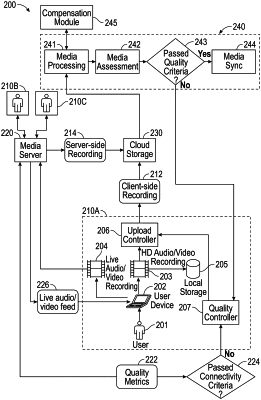| CPC H04N 19/105 (2014.11) [H04N 19/154 (2014.11); H04N 19/59 (2014.11); H04N 21/4307 (2013.01)] | 23 Claims |

|
1. A method comprising:
receiving, at a server, media data comprising a first media content segment, the first media content segment comprising first audio data uploaded by a first user device and first video data uploaded by the first user device, the first media content segment encoded according to a first set of encoding parameters;
determining, by the server, whether a fault has occurred, the fault associated with the first media content segment, wherein determining whether the fault has occurred comprises determining a quality value of the first media content segment and determining whether the quality value exceeds a threshold;
receiving a second media content segment, the second media content segment comprising second audio data and second video data, the second media content segment encoded according to a second set of encoding parameters;
in accordance with a determination that the fault has occurred, replacing, in the media data, the first media content segment with the second media content segment;
in accordance with a determination that the fault has not occurred, forgoing replacing, in the media data, the first media content segment with the second media content segment, and
providing the media data from the server to a client device for presentation of the media data;
wherein replacing the first media content segment with the second media content segment comprises:
synchronizing a first time of the second media content segment to a corresponding first time of the first media content segment, the first time associated with the fault, and
trimming a length of the second media content segment to a length of the first media content segment.
|